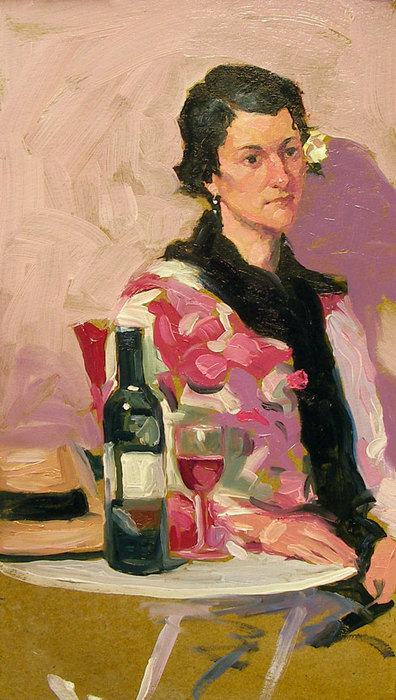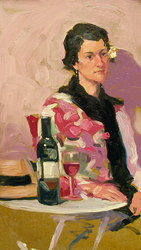Color 101
Learning the essentials of good painting does not have to be expensive. All good paintings have three things in common and in order of importance and they are, 1) good composition, 2) good contrast and 3) good colour.
This Alla Prima painting was painted using the 3 primaries, plus black & white.
The least expensive way for beginning painters to master colour is to learn to mix colour using the three primary system. These are colors that are made from a single pigment. Using this system, the artist only needs only five tubes of paint and most of those colours are a series four or less in the professional grade. In the student grade, colours made by the same manufacturers cost even less.
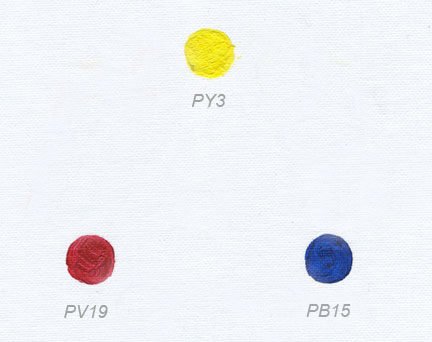
The three primary pigments are : PV19 (red), PY3 (yellow) and PB15 (blue). These pigments are the same used in printer's inks and when combined with white and black can replicate pretty much any colour.
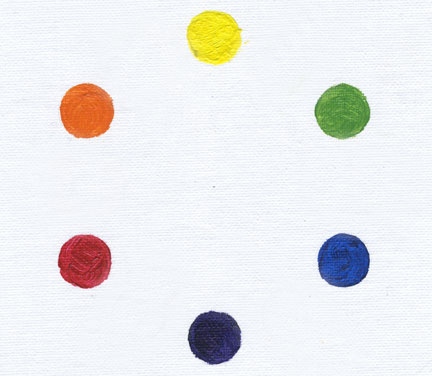
The primaries create a triangle which become the base (parent) colours of the wheel. When each parent colour is mixed with its neighbour, they create a secondary colour. Red mixed with yellow makes Orange. Blue mixed with Red makes Violet and Yellow mixed with Blue makes Green. So, Orange, Violet and Green are the secondary colours, creating another triangle on the wheel.
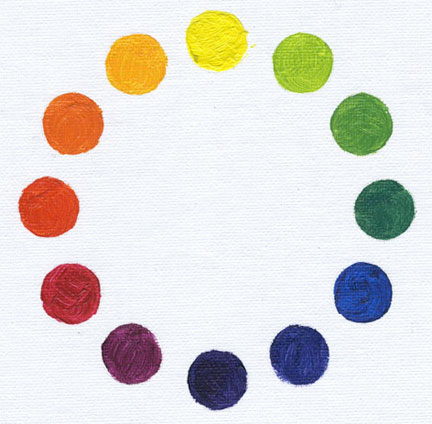
To finalize the wheel, the primaries are again mixed with their new nerighbouring secondaries. This new mixing creates six more colours on the wheel called tertiary colours and complete the wheel. Red mixed with Orange makes the tertiary Red-Orange and Red mixed with Violet makes the tertiary Red-Violet. Yellow mixed with Orange makes the tertiary Yellow-Orange and Yellow mixed with Green makes the tertiary Yellow-Green. Blue mixed with Green makes the tertiary Blue-Green and Blue mixed with Violet makes the tertiary Blue-Violet.
Now the wheel is complete.
Which now brings us to complementary colours. Complementary colours are opposites and opposites create contrast, just as light against dark create contrast, but more about that later.
Simply put, complementary colours are located directly across from one another on the colourwheel. For example, Primary Red is directly across the wheel from the secondary Green. This makes them complements (opposites). The Primary Red was not a parent to the secondary green and therefore unrelated. The same is true for Yellow and Violet and accordingly, Blue and Orange. The same is true for the tertiary colours. Red-Violet is directly across the wheel from yellow-green and so on.

Mixing complements neutralize. Therefore, a complementary can be used to mute its opposite. Red mixed with Green can create varying degrees of brown. The same is true when mixing the other two primaries with their complementary secondary.
COLOUR HARMONY
On the colourwheel there exists colour groups (also known as families). These groups are based on the parent primaries. So, there is The Red Group, The Blue Group and The Yellow Group. Colour Harmony is created when one group dominates.
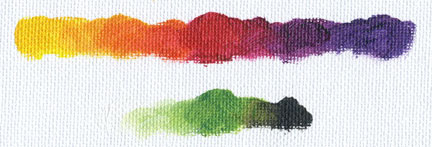
The Red Group consists of all the colours on the wheel that include the Red parent. Red, Red-Orange, Orange, Yellow-Orange, Red- Violet, Violet and Blue-Violet. The complements for this group are any from the green secondary group (Green, Yellow-Green and Blue-Green).
The Blue Group
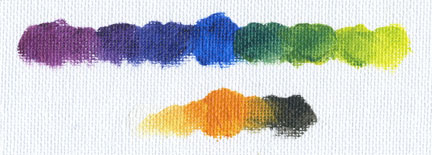
Red-Violet, Violet, Blue-Violet, blue, Blue-Green, Green and Yellow-Green. Their compliments: Red-Orange, Orange, and Yellow-Orange.
The Yellow Group
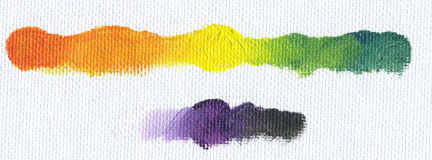
Red-Orange, Orange, Yellow-Orange, Yellow, Yellow-Green, Green and Blue-Green. Their complements: Red-Violet, Violet and Blue-Violet.
Complements are used to neutralize; white to tint (lighten), black to shade (darken).
The primary colours are unrelated and therefore can only exist harmoniously with colours that are in their own group or family. Red can only harmonize with colours that contain red, yellow only with colours that contain yellow and blue with colours that contain blue. So, a painting that has colour harmony is one that has a dominant primary group. Good paintings have one or more of three dominant ingredients: Dominant primary group, dominant temperature (warm or cool) and dominant value (dark, light or middle). Contrast is achieved when a dominant ingredient is put next to its opposite. In painting, areas of contrast become focal points, or accents, and are useful in guiding the observer's eye through the painting. So, a dominant colour con be accented by it's complement, a dark painting can have light accents (and vise versa) and a warm painting can have cool accents (and vice versa).
MIXING EARTHTONES
It is possible to also mix earthtones using just the primaries:
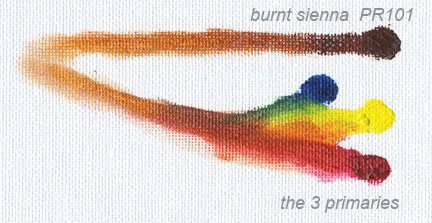
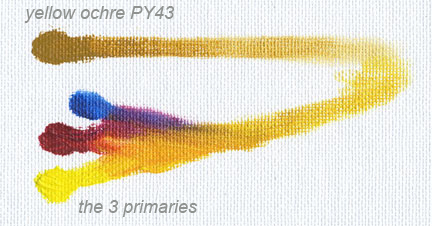
Below are two colour sketches that illustrate dominants and opposites
DAYLIGHT

Here, the primary yellow group is used as the dominant group, and green as the dominant colour. The colours used are from the violet complement group to mute and red-violets are used as accents. The area of most contrast in value is the house which becomes the focal point in the painting.
NOCTURNAL
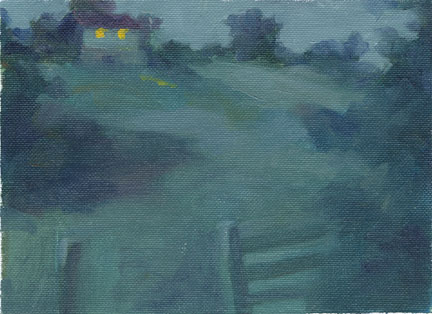
Here, the primary blue group have been used and are muted with the blue-violets and blue-greens with orange. The complementary yellow orange is used to create a high contrast, light against dark, focal point. Again, it is the house.
© Takapuna Art Supplies
How to buy
Note: we do not deliver outside New Zealand.
Enter the quantity and click "add to cart". When you are ready to pay for your order proceed to checkout. Payment is made by credit card on a secure server using Paypal or Payment Express. Alternatively you may pay by "bank deposit" or by phone on 09 489 7213.
Delivery Rates
Our delivery rates are:
- Prepaid A4 Satchel (nationwide): $5 per order †
- Local (Auckland): $5.50 per order *
- Local Towns (within 150kms): $7.50 per order *
- Rest of North Island: $9.30 per order *
- South Island and Great Barrier: $10.40 per order *
† Prepaid Satchel is available for some smaller items that will fit into an A4 envelope. Please do not select the satchel option if your goods are breakable, easily damaged or flammable.
* Oversized items may be charged an additional amount - once you have selected the items you need proceed to checkout to see the exact costs.
Rural delivery fee $3.30 per order
For privacy, returns and security policies please read our policies page.
About Takapuna Art Supplies
When we purchased Takapuna Art Supplies in April 2007 our intention was to make new friends and create an environment where professional and casual artists can purchase quality supplies and receive expert service and advice. Now, our most frequent comment from customers is, "what an artist's treasure-trove!" In February 2009 we added our tasart online store and we are now giving the same service, advice and selection to artists all over New Zealand. We stock over 17 thousand products and offer over 100 brand names and we continue to grow monthly with new product additions, tutorials and consumer information.
As fellow artists, we want every customer who walks into our shop or who shops on our online store, to be treated to a Smorgasbord of brand names from which they can choose. We are proud to say that we do not own the agency for any of the brands carried in our stores and, therefore, our customers can be confident that the product advice given by us is expert, sincerely informative and not tainted by conflicting profit guided prejudice. We purchase our supplies exclusively from reputable wholesalers and sell our stock at or below the manufacturer’s recommended resale price. Learn more about us...

